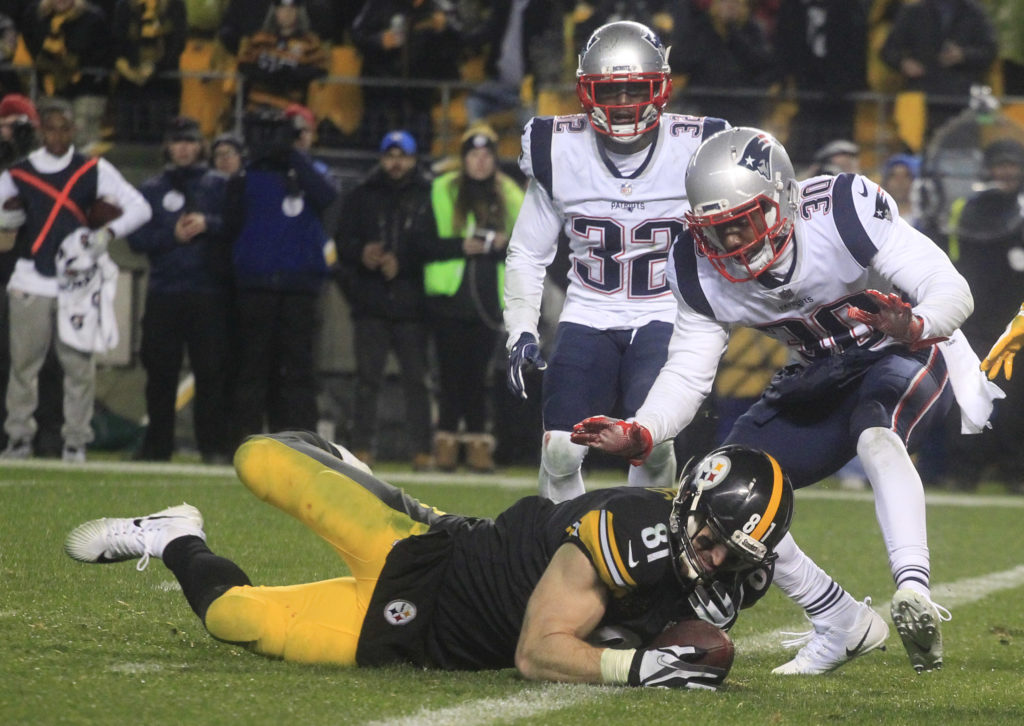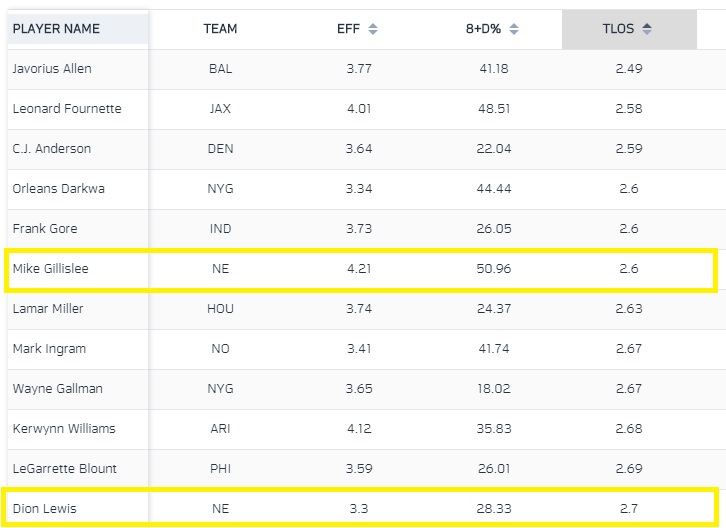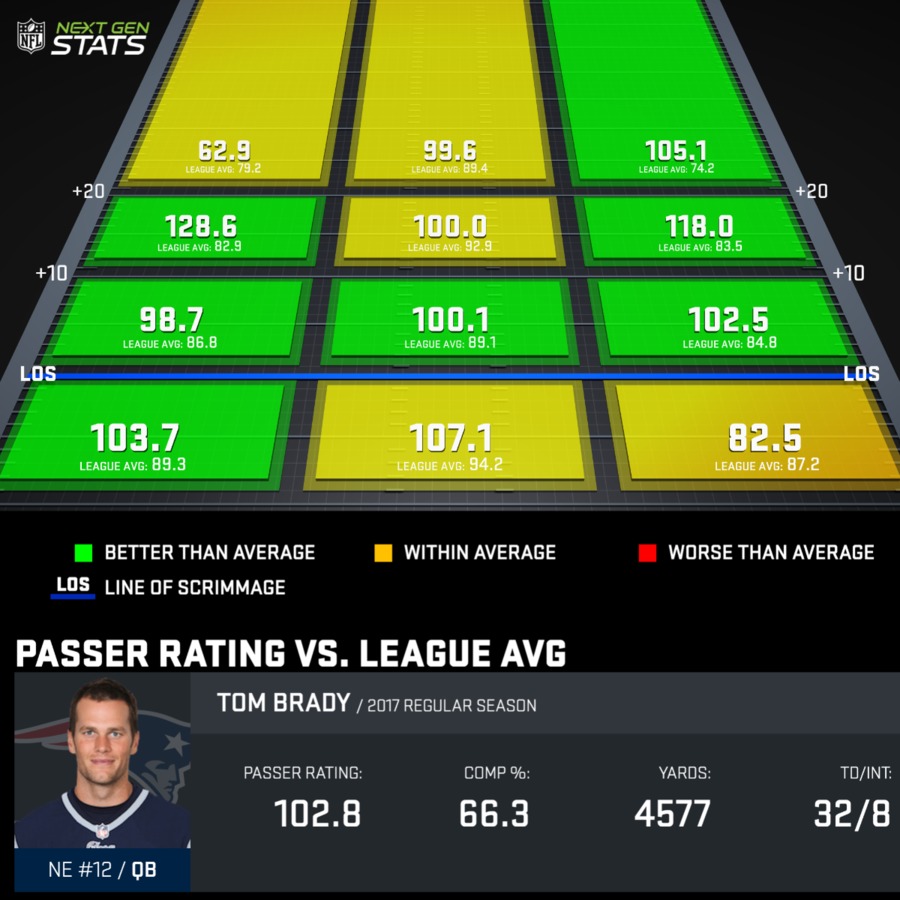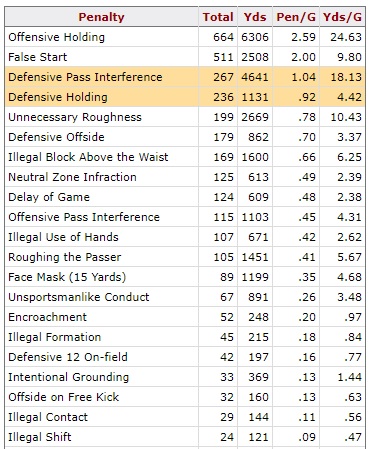Ad Disclosure
Super Bowl 52: Advanced Stats, Climatology, and Questionable Officiating

This is part three of our Super Bowl 52 preview.
In part one, I wrote about the Patriots’ special teams:
Super Bowl 52: A Look at New England’s Special Teams Unit
And in part two, I wrote about Tom Brady and company:
Super Bowl 52: A Look at New England’s Offense
Sean Cottrell is doing the defensive write-up, so I’m gonna do the statistical and miscellaneous stuff in part three. I know that seems kind of goofy, but we wanna keep this thing rolling, so you’re just gonna have to deal with it.
I went through basically every piece of random information I could find about the filthy cheaters.
Situational and advanced stats
Let’s start with football outsiders, and the log of advanced drive statistics.
The chart below is organized by yards per drive, turnovers per drive, and average starting field position (LOS). Time of possession is in there, too (TOP), along with drive success rate, which I’ll explain below:
You see the Pats are #1 in the NFL in yards, plays, and points per drive. They have the second lowest turnover rate and the fourth best time of possession per drive.
They’re #1 in that DSR category, “drive success rate,” which is a measure of every “down series that results in a first down or touchdown.” In layman’s terms, they move the chains or score a touchdown on 76.7% of each set of downs. That’s a monstrous number. The Giants were dead last in that category, way down at 62.2% with a ton of three and outs to their name.
It’s a mistake-free, efficient offense that knows how to move the ball down the field.
As far as the red zone, Tom Brady threw 31 of his 32 touchdowns inside the 20 with a 62% completion rate and 0 interceptions.
I repeat – zero red zone picks for Brady this year, while 19 NFL starters threw at least one.
Rob Gronkowski caught 7 touchdowns on 23 red zone targets and Dion Lewis led the NFL with a 100% catch rate inside the 20, which is another insane number. He had 13 grabs on 13 targets for three touchdowns. Danny Amendola caught 83% of his red zone targets to finish right at the edge of the top-10. They are simply deadly in that portion of the field.
New England scored touchdowns on 63.29% of their red zone trips, finishing third in the NFL behind…
…the Jaguars and Eagles, so no wonder all three teams made it as far as they did.
There are some interesting things over at the NFL’s NextGen stats page, too.
Lewis is a bit of a smaller guy and a good pass catcher, so you’d think he’d be a more measured and deliberate east-west runner.
Not really.
He finished top-15 in one of my favorite metrics, “time behind line of scrimmage,” which measures – you guessed it – how much time a ball carrier spends behind the line of scrimmage.
Basically, guys with a low TLOS number are downhill types who quickly hit the hole. The front-end of the list is populated with the likes of Leonard Fournette and LeGarrette Blount, but Lewis is right up there, along with injured teammate Mike Gillislee:
Lewis spends an average of 2.7 seconds behind the line of scrimmage, so he’s actually hitting the gaps rather quickly in a north-south fashion.
For comparison, the NFL’s most patient runners, guys like Le’Veon Bell and Tarik Cohen, are bottom-five with a 3.11 and 3.37, respectively. That doesn’t sound like much of a difference numbers-wise, but it’s a good indicator of what type of runner you’re dealing with.
Rob Gronkowski’s numbers are very interesting as well, and they show that he’s one of the most blanketed players in the NFL.
His cushion number is 4.6, 4th lowest in the NFL. That means that defenders who line up across from him are giving him an average of 4.6 yards in distance. Only Antonio Brown, Amari Cooper, and Marvin Jones had corners and safeties meeting them closer to the line.
And Gronk’s SEP, or separation number, is 17th-lowest in the NFL. He’s only getting 2.3 yards of separation from defenders on each target. Alshon Jeffery’s 1.8 number is lowest in the league, which illustrates how he doesn’t burn defenders in coverage, but makes contested catches instead.
Same for Gronk, right? Sort of.
Gronkowski’s catch percentage is not as high as you’d think it is, just 65.71, well below guys like Zach Ertz (67.27), Jason Witten (72.41), and Benjamin Watson (77.22). So even though Gronk is a Pro Bowl talent and 1,000 yard receiver, he didn’t catch as many balls as I first thought. More than 33% of his yardage came after the catch, and that’s what makes him really dangerous. Among all tight ends, only Travis Kelce had more YAC yards in 2017.
Finally, Brady falls into the middle of the pack in a metric called “aggressiveness,” which measures how often a quarterback throws into tight coverage, defined as a defender being within 1 yard or less of a receiver. Tom’s number is 17.4%, so he’s really only throwing into small windows once every five or six attempts. Carson Wentz actually led the league with a 25.7% mark in this category, which complements the Jeffery stat I mentioned above. The fact that Carson threw into those types of windows consistently and still logged the numbers he did shows just how damn good he was.
As far as passer rating, Brady was off the charts this season.
Check this out:
Brady was above the league passer rating average in 10 of 12 field quadrants. The only areas where he didn’t destroy the opposition were deep balls to his left side and flat passes to his right.
The NFL also measures the TTT metric, which is “time to throw,” the number of seconds between the snap and release. Brady’s number is 2.7 seconds, for 18th overall. Middle of the pack.
What’s the weather gonna be?
I swear I’m only doing this section because it’s the biggest game of all time, and we need to know every god damn angle and piece of information we can, so that we can use it to our advantage while sitting on our couches and watching the game.
The Super Bowl is in a dome. It’s on a turf field. New England plays on turf in an outdoor setting in Foxborough. The Eagles play on grass at the Linc, also outdoor.
Here’s a look at how the Patriots did in their ten home games at Gillette, with some temperature stats from NFLWeather.com:
- September 7th – Chiefs 42, Pats 27 (Thursday night game, 62 degrees, clear, 1 mph wind)
- September 24th – Pats 36, Texans 33 (day game, 84 degrees, clear, 0 mph wind)
- October 1st – Panthers 33, Pats 30 (day game, 61 degrees, clear, 1 mph wind)
- October 22nd – Pats 23, Falcons 7 (night game, 56 degrees, partly cloudy, 0 mph wind)
- October 29th – Pats 21, Chargers 13 (night game, 61 degrees, light rain, 1 mph wind)
- November 26th – Pats 35, Dolphins 17 (day game, 46 degrees, partly cloudy, 4 mph wind)
- December 24th – Pats 37, Bills 16 (day game, 34 degrees, clear, 1 mph wind)
- December 31st – Pats 26, Jets 6 (day game, 11 degrees, clear, 5 mph wind)
- January 13th – Pats 35, Titans 14 (night game, 26 degrees, clear, 9 mph wind)
- January 21st – Pats 24, Jaguars 20 (day game, 48 degrees, clear, 2 mph wind)
They were 8-2 at home this season if you include that pair of playoff wins. And the two losses took place early in the season during weeks 1 and 4 They’re 13-1 since October 1st.
There’s not a ton to talk about here. They had some light rain in the Chargers win but avoided the worst of the Nor’Easter that went up the coast that weekend. The only time they had any real wind was in the Titans playoff win, and Stephen Gostkowski missed a field goal in that win, so maybe the 9 mph had something to do with it. Obviously there will be no wind issues in the dome.
Here’s how they did in eight road games:
- September 17th – Pats 36, Saints 20 (dome)
- October 5th – Pats 19, Buccaneers 14 (Thursday night game, 77 degrees, partly cloudy, 4 mph wind)
- October 15th – Pats 24, Jets 17 (day game, 71 degrees, mostly cloudy, 4 mph wind)
- November 12th – Pats 41, Broncos 16 (night game, 48 degrees, partly cloudy, 0 mph wind)
- November 19th – Pats 33, Raiders 8 (day game, 64 degrees, mostly cloudy, 3 mph wind)*
- December 3rd – Pats 23, Bills 3 (day game, clear, 46 degrees, 2 mph wind)
- December 11th – Dolphins 27, Pats 20 (Monday night game, clear, 56 degrees, 3 mph wind)
- December 17th – Pats 27, Steelers 24 (day game, 40 degrees, rain, 0 mph wind)
That’s three road games on turf and five road games on grass, including the November trip to Mexico City to play the Raiders at the Azteca.
Adding the home games at Gillette, Brady finished 11-2 on turf and 4-1 on grass.
Only one dome game this year, and that was way back on week two against a Saints team that I don’t think was clicking yet. For what it’s worth, Tom Brady was marvelous in that game, going 30-39 for a season high 447 yards and three touchdowns.
Historically, he’s always played well in domes. According to pro-football reference, he’s 11-2 in 13 regular season dome games:
And in the playoffs, I had to search manually since I could not, for the life of me, career playoff splits. Maybe I’m an idiot.
Anyway, Brady lost in a dome against the Colts back in 2006. That’s the only non-Super Bowl dome game I found.
He won the 2017 Super Bowl in the Texans’ stadium with the roof CLOSED. He won the 2015 Super Bowl in the Cardinals’ stadium with the roof OPEN. He lost the 2012 Super Bowl in Indy with the roof CLOSED. He also lost the 2008 Super Bowl in Arizona with the roof CLOSED, but he beat the Rams and Panthers in CLOSED roof domes.
Make sense?
He’s 5-3 in the playoffs playing inside of a dome, with a sixth win coming in a stadium where the roof was open.
Penalties and officiating
One thing that jumped out at me the other day was the fact that the Patriots led the NFL with 50 first downs resulting from opponent penalties.
Could it mean that…
…they get all of the calls?
I mean, it could. People always say the Pats get it easy from the officials, or that Bob Kraft is paying them off, which is probably why there’s no money left to spend on the soccer team that he probably forgets that he owns.
But it’s also the product of running empty set with a lot of tricky looks and picks and rubs, situations where you’re going to draw pass interference calls at a higher rate than other teams.
According to pro-football reference, defensive pass interference and defensive holding were the second-most flagged infractions this season:
Offensive holding was #1, and that’s another highly subjective flag. False starts are fairly linear, though. You either move or you don’t, so it’s not like refs can make shitty false start calls, unless a defender jumps in response, right?
The Patriots threw the ball 587 times this year, 7th-most in the NFL. That means there’s just going to be more raw play totals where defenders can be flagged for pass interference and holding. And the Pats are throwing 4 or 5 receivers at you on a lot of passing plays.
NFLPenalties.com says New England received the 2nd-fewest flags this year, just 5.56 per game. And their opponents received the 8th most flags, with a 7.06 average in their 16 games against New England.
Sniff sniff…
Smells fishy to me!
And of course you remember the ridiculous end to the Pats/Steelers game in December, where Pittsburgh had a game-winning touchdown overturned:

Look, I understand why they made that call, but if the guy crosses the plane with the ball, is that not a touchdown? If a runner got the nose of the ball across the line before fumbling out of the end zone, it would be a touchdown. Why is this different?
I digress..
I’m not saying the refs are in the bag for the Patriots, but they always seem to get the favorable calls. Isn’t it ironic? Don’t you think?
Last, but certainly not least, Super Bowl 52 will be officiated by Gene Steratore and his crew. They did the Eagles/Broncos game this year, hitting Denver with 14 penalties for 105 yards. The Birds were flagged 5 times for 35. That’s good. And there’s more good, because Gene grew up in Uniontown and might be secretly helping us out this weekend:
Gene Steratore is the Super Bowl head referee. He’s a native of Pennsylvania and Philly is 10-3 when he refs, 5-0 since 2013. Something tells me the Eagles will get some favorable defensive & offensive pass interference calls.@GStera @Patriots @KristineLeahy @ColinCowherd @NFL
— Fred Fredburger (@SpecialMaster45) January 27, 2018
Kevin has been writing about Philadelphia sports since 2009. He spent seven years in the CBS 3 sports department and started with the Union during the team's 2010 inaugural season. He went to the academic powerhouses of Boyertown High School and West Virginia University. email - k.kinkead@sportradar.com




